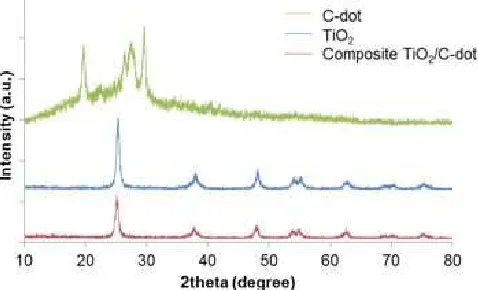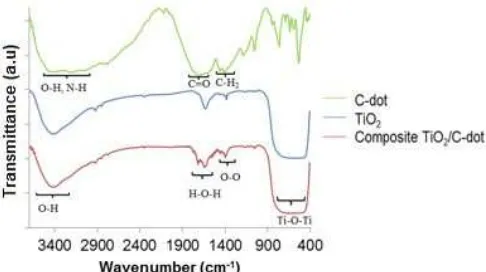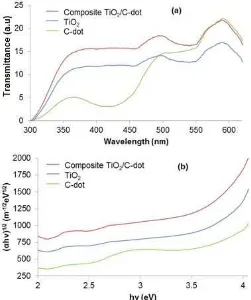Synthesis of TiO2/Carbon Nanoparticle (C-dot) Composites as Active Catalysts
for Photodegradation of Persistent Organic Pollutant
Dedri Syafei, Sri Sugiarti
*, Noviyan Darmawan, and Mohammad Khotib
Department of Chemistry, Bogor Agricultural University, Chemistry Building, Wing 1, 3rdFloor, Jl. Tanjung, IPB Darmaga Campus, Bogor 16680, Indonesia
Received April 29, 2016; Accepted January 24, 2017
ABSTRACT
Perchloroethylene (PCE) is a persistent organic pollutant that can pollute soil and water due to its toxic nature. Photodegradation technologies are being suggested to degrade waste into harmless final products. The TiO2 was
used as the photocatalyst and composited with carbon nanoparticles (C-dot) to increase its photocatalytic activity under visible light. C-dots absorb light in the visible region and emit shorter wavelength light which can potentially be used by TiO2to activate its photocatalytic property. The TiO2/C-dot composites were synthesized by sol-gel method.
The photoluminescence properties of C-dots and the composites were observed by visual analysis and fluorescence spectrophotometer analysis. Synthesized composites were characterized by XRD, FTIR, and UV-Vis spectrophotometer. UV-Vis spectrophotometer analysis showed a decrease in the band gap of TiO2/C-dot
composites. Photocatalytic degradation of PCE 0.1% (v/v) in the aqueous phase was investigated under sunlight irradiation for 2 h. The results of the gas chromatography analysis showed that composites of TiO2/C-dot 2.5% (w/w)
successfully degraded PCE under sunlight irradiation with photodegradation ability of up to 89.45%.
Keywords:perchloroethylene; photocatalytic; photodegradation; TiO2/C-dot composites
ABSTRAK
Perkloroetilen (PCE) merupakan senyawa percemar organik persisten yang dapat mencemari tanah dan air karena bersifat racun. Teknologi fotodegradasi dapat diusulkan untuk mendegradasi limbah menjadi produk akhir yang tidak berbahaya. TiO2 digunakan sebagai fotokatalis, dan dikompositkan dengan carbon nanopartikel (C-dot)
untuk meningkatkan aktivitas fotokatalitiknya di daerah sinar tampak. C-dot menyerap sinar di daerah sinar tampak, dan melepaskan cahaya dengan panjang gelombang lebih pendek yang berpotensi sebagai sumber cahaya untuk mengaktivasi sifat fotokatalitik TiO2. Komposit TiO2/C-dot disintesis menggunakan metode sol-gel. Sifat fotoluminesens ditunjukkan dari analisis visual dan spektrofotometer fluoresens. Komposit hasil sintesis dikarakterisasi menggunakan XRD, FTIR, dan spektrofotometer UV-Vis. Analisis spektrofotometer UV-Vis menunjukkan terjadi penurunan nilai energi celah pada komposit TiO2/C-dot. Degradasi PCE 0.1% (v/v) dalam fasa
air telah diselidiki di bawah sinar matahari selama 2 jam. Formulasi hasil analisis kromatografi gas menunjukkan komposit TiO2/C-dot 2.5 (b/b) berhasil mendegradasi PCE di bawah sinar matahari dan kemampuan fotodegradasi
mencapai 89,45%.
Kata Kunci:fotodegradasi; fotokatalitik; komposit TiO2/C-dot; perkloroetilen
INTRODUCTION
Persistent organic pollutants (POPs) are chemical substances that persist in the environment and pose a risk of causing adverse effects to human health and the environment. Perchloroethylene (PCE) is a persistent organic pollutant of soil and water because it is toxic, carcinogenic, and extremely long-lasting in the environment [1]. PCE is widely used as an industrial solvent for degreasing metals and for dry cleaning [2]. Sonochemical degradation [3] and photocatalytic degradation [4] have been considered as methods to reduce the amount of POPs in the environment.
Photodegradation by photocatalysts such as TiO2, ZnO, CdS is a more attracting method as the catalysts are highly available, easier to handle, and usually, produce harmless final products [5].
further improvement. Here, we are reporting a new material with improved TiO2 photocatalytic activity under UV light, by using a light absorber material, carbon nanoparticles (C-dots), to form TiO2 composites. The synthesized composite is a natural progression from the results reported by Li et al. [8] who mixed carbon quantum dots (CQDs) with TiO2 and used it to photodegrade methylene blue with efficiency close to 100%.
C-dots are the analog of CQDs which has a similar structure with graphite and have various properties, such as their good solubility in water, cheap starting materials, efficient synthesis process, low toxicity, good photostability, and strong photoluminescence [9-10]. C-dots have strong luminescence property in the UV-to-near-infrared range [8]. In this study, C-dots were combined with TiO2 and used as a catalyst in the photodegradation of PCE. The C-dots are believed to act as a source of light for the electron excitation in TiO2, as C-dots absorb light at a higher wavelength and emit light at a shorter wavelength due to upconversion of its photoluminescence, similar work was previously reported by Zhang et al. [11] by applying Fe2O3/C-dots composite photocatalyst. A hole (h+) will be formed when an electron on TiO2 exits from the valence band to the conduction band, which will then react with a water or hydroxyl ion (-OH) to form a hydroxyl radical (•OH). This radical is very active in attacking organic molecules such as PCE and degrade it into more friendly substances such as CO2and H2O. However, the C-dots might act as a dopant. Determination of band-gap energy is needed to give an insight on the role of C-dots in the composites.
EXPERIMENTAL SECTION
Materials
All chemicals used were an analytical grade, i.e. citric acid, urea, ethanol, and ammonia from Merck, tetrabutyl titanate from Sigma-Aldrich, n-heptane, and perchloroethylene from BDH, and deionized water.
Instrumentation
The instruments used in the synthesis of C-dots, TiO2, and TiO2/C-dot composites were a Sharp R-249IN 800 W microwave oven, laboratory oven, and Hermle
Procedure
Catalysts preparation
The C-dots were synthesized by the microwave method [12]. Typically, citric acid (0.5 g) and increasing amounts of urea (0, 20, 60 and 80% (w/w) were transferred into 10 mL deionized water. The solution was then heated by microwave oven for 4 min until the color of the solution changed from a colorless to brown liquid and finally formed a dark-brown precipitate. This solid material was then heated in an oven at 60 °C for 1 h to remove the residual water. An aqueous solution of C-dots was purified by centrifuging at 5000 rpm for 20 min to remove large agglomerated particles. The liquid phase of C-dot underwent a solidification process on a hot plate.
Fig 1.(a) C-dots, (b) C-dot aqueous solution (100 mg/L), (c) TiO2and composite TiO2/C-dot, (d) TiO2and composite TiO2/C-dot solution (100 mg/L) under daylight, (e) under 365 nm UV lamp source
Photocatalytic experiments
TiO2/C-dot composites, pure TiO2, and pure C-dots (0.1 g each) as catalysts were added to PCE 0.1% (v/v) (25 mL) and then irradiated under sunlight for 2 h. The solution was then extracted by n-heptane (25 mL). The organic phase was analyzed by GC to measure the residual concentration of PCE to observe photodegradation ability of composites under visible light.
RESULT AND DISCUSSION
Catalyst Preparation Results
The synthesized C-dots appeared to have dark brown color (Fig. 1a) and were found to have a lower yield as the urea concentration increased. The yield of synthesized C-dot without the addition of urea was obtained at 99.06%. The addition of 20, 40, 60 and 80% urea gave the yield of C-dot at 91.29, 85.53, 75.87, and 37.87%, respectively. It was also found that the higher the amounts of urea in the synthesis of C-dots, the higher the agglomeration of formed C-dots. However, similar to that reported by Sugiarti [10], emission intensity increased with the increased concentration of urea as a passivation agent in the reaction process. The photoluminescence from C-dots that have surface passivation is attributed to the presence of surface energy traps that become emissive upon stabilization [13]. The intensity of luminescent emission from C-dot solutions was determined by a visual analysis under UV light (365 nm). C-dots synthesized with 80% of urea had greater luminescent intensity compared with the other C-dots. The increased intensity of luminescent shows the effect of urea as a passivation agent on the C-dot surface. Therefore, C-dots from citric acid-urea 80% were chosen to be combined with TiO2.
The TiO2/C-dot composites had a darker color than the TiO2 and were close to the dark brown color of C-dots (Fig. 1c). This indicated the presence of C-dots in the composites. The intensity of luminescent emission of the TiO2/C-dot composite solutions was observed under UV light (365 nm) as shown in Fig. 1e. The fluorescence
Fig 2.X-ray diffraction of C-dots, TiO2/C-dot composite, and TiO2
properties of C-dots in the composites were observed even though the photostabilities of the solution decreased due to a decrease in the transparency of the solution in the presence of TiO2. Photostabilities properties such as strong photoluminescence properties are generated when the C-dots freely dispersed in water with a transparent appearance [8].
X-Ray Diffraction Analysis Results
X-ray diffraction (XRD) analysis was done on C-dots from citric acid-urea 80%, on the composite TiO2/C-dot 2.5%, and on TiO2.The resulting analysis is illustrated in Fig. 2. X-ray diffraction patterns of the
C-dots exhibited intense peaks at 2θ (intensity)
= 19.73° (77); 27.52° (79); and 29.60° (98). These peaks were attributed to highly disordered carbon atoms [12]. The crystallinity of the C-dots was 30.4564%. XRD patterns of the TiO2/C-dot composites exhibited intense peaks at 2θ (intensity) = 25.19° (59);
37.77° (18); and 47.96° (12). The crystallinity of the TiO2/C-dot composites was 78.2537%. For TiO2, the XRD pattern exhibited intense peaks at 2θ (intensity) =
relatively amorphous C-dot in the composite. However, there were no significant changes in the XRD pattern of the composites compared to the XRD pattern of TiO2. All peaks on TiO2/C-dot were similar with the diffraction angle of TiO2, indicating that there was no new compound formed from mixing C-dot with TiO2.
Functional Group Analysis Results
Functional group analysis by FTIR was done on the C-dots from citric acid-urea 80%, on the TiO2/C-dot 2.5% composite, and on TiO2. Fig. 3 shows the FTIR spectra of the samples. The FTIR results for the C-dots were similar to those reported by Qu et al. [8], with an absorption band at 1600-1770 cm-1for C=O and for the CH2 vibration occurred in the region of 1350-1460 cm
-1 . These absorption bands did not appear in the FTIR results for the TiO2/C-dot composite. The TiO2/C-dot composite spectra were similar to the spectra of TiO2 with an absorption band for Ti-O-Ti in the region of 400-800 cm-1[15]. An absorption band at 1054 cm-1was due to stretch vibration of O-O. Absorption bands at 1631 and 3420 cm-1were due to H-O-H (water) vibration and O-H (hydroxyl) vibration [14]. So, based on the FTIR analysis we conclude there was no chemical bond between TiO2 and C-dot because there were no other absorption bands formed in the TiO2/C-dot composite such as C=O and CH2vibration bands.
Spectrum of Fluorescence Intensity
Fluorescence intensity measurement was performed on C-dots from citric acid-urea 80%, TiO2 /C-dot 2.5% composite and TiO2 to determined maximum fluorescence emission of the samples. Fig. 4 shows the analysis results. The maximum fluorescence emission of C-dot was at the wavelength of 536.33 nm when it was excited at a wavelength of 405 nm ± 10. The recorded maximum emission spectrum was higher than reported by Sugiarti [10], where C-dot synthesized from ascorbic acid-urea 75% has a maximum emission at wavelength 500 nm when excited at a wavelength of 400 nm. This difference may be due to the influence of passivation agent concentration on C-dots in the reaction process. The C-dots did not lose their fluorescence properties in the composite with TiO2. The maximum fluorescence emission of TiO2/C-dot composite was at the wavelength
the C-dot, TiO2/C-dot composite, and the TiO2 was done by measuring their absorption using UV-Vis spectrophotometer [16]. Fig. 5a shows the UV-Vis spectra of the C-dots from citric acid-urea 80%, TiO2 /C-dot 2.5% composite, and TiO2. The absorption coefficient value (α) is obtained from –lnT/d. The film
thickness (d) was measured using Teclock 0.01 mm, to obtain the thicknesses of the C-dots, TiO2/C-dot composite, and TiO2 of 0.025; 0.005; and 0.01 mm, respectively.
The function (αE)1/2
= B(E-Eg), which was obtained using the Tauc’s Plot method, intersects the
hν axis at Eg, and B is the slope. The optical band gap
(Eg) was obtained by linear extrapolation of graph hν (or E) and (αhν)1/2
until it crosses the energy axis (E) [16,17] (Fig. 5b), where h is Planck’s constant = 4.136
x 10-15eVs and ν is the UV-Vis frequencies which are
Fig 3.FTIR spectrum of C-dots, TiO2/C-dot composite, and TiO2
Fig 4. Fluorescence emission spectrum of C-dots,
Fig 5. (a) Wavelength versus transmittance spectrum and (b) the optical band gap energy
Fig 6. Photocatalytic activity of TiO2/C-dot composites on PCE 0.1% (v/v) under sunlight
obtained by dividing the speed of light (c) = 2.998 x 108
m/s with the wavelength (λ).
According to the calculation from the Tauc’s Plot the optical band gap energy of the C-dots, TiO2/C-dot composite, and TiO2 are 2.79; 3.10; and 3.23 eV, respectively. These results show that C-dots can reduce the band gap of TiO2 in the TiO2/C-dot composite thereby widening the TiO2uptake range.
Photocatalytic Experiment Results
The experiments were done for TiO2/C-dot composites using 25 mL PCE 0.1% (v/v) under sunlight irradiation for 2 h. Fig. 6 shows the photocatalytic activities of the catalysts. The concentration of PCE was decreased with increasing quantity of C-dots in the TiO2/C-dot composite compared to pure TiO2 as a catalyst. This proved that C-dots are effective in improving TiO2 photocatalytic activities under sunlight. PCE was successfully degraded and its photodegradation ability was up to 89.45% using the TiO2/C-dot 2.5% composite as a catalyst. Whereas under the same conditions, pure TiO2 and pure C-dot showed lower degradation ability (54.52 and 46.33%, respectively). According to Ming et al. [18], C-dots have peroxidase-like ability to degrade pollutant compounds. The photocatalytic ability of C-dots are derived from the C-dot properties of being very soluble in water, and of having protons that are easily taken from the C atoms in C-dots, such that H2O and H2O2 can readily be transformed into hydroxyl radicals (•OH) during photoreaction.
In this study, the role of C-dots in the PCE photodegradation process by the TiO2/C-dot composites was seen from the success of C-dots to decrease the optical band gap energy of TiO2, so that the photocatalytic process can occur over a larger range of wavelengths. However, the lowering value of TiO2 band gap energy in the composite was not great, suggesting that the C-dots also play another role in the composites. Zhang et al. [11] reported that C-dots play important roles in photocatalytic processes as an electron reservoir to trap electrons thus preventing electron-hole recombination.The oxygen radicals (•O2-) can be formed by the reduction reaction of oxygen (O2) by electrons on the surface of C-dots, subsequently, the hydroxyl radicals (•OH) is produced by the reaction of •O2
-with water. The C-dots can absorb light at a longer wavelength and then emit light at a shorter wavelength as a result of their upconversion photoluminescence property which could, in turn, excite TiO2 electrons from valence band to conduction band, a process that results in the formation of holes (h+). The •
and increasing the TiO2 photocatalytic activity. The TiO2/C-dot 2.5% (w/w) composite successfully degraded 89.45% of the PCE tested under sunlight.
ACKNOWLEDGEMENT
The authors would like to thank the Indonesian Ministry of Research, Technology, and Higher Education which sponsored this research.
REFERENCES
[1] Yu, S., and Semprini, L., 2009, Enhanced reductive dechlorination of PCE DNAPL with TBOS as a slow-release electron donor,J. Hazard. Mater., 167 (1-3), 97–104.
[2] Bukowski, J.A., 2011, Review of the epidemiologic literature on residential exposure to Perchloroethylene, Crit. Rev. Toxicol., 41 (9), 771– 782.
[3] González-García, J., Saez, V., Esclapez, M.D., Bonete, P., Walton, D.J., Rehorek, A., and Louisnard, O., 2010, Sonochemical degradation of Perchloroethylene, Physics Procedia, 3 (1), 981– 986.
[4] Monteiro, R.A.R., Silva, A.M.T., Angelo, J.R.M., Silva, G.V., Mendes, A.M., Boaventura, R.A.R., and Vilar, V.J.P., 2015, Photocatalytic Oxidation of Gaseous Perchloroethylene over TiO2 Based Paint,
J. Photochem. Photobiol., A, 311, 41–52.
[5] Pera-Titus, M., Garcı́a-Molina, V., Baños, M.A., Giménez, J., and Esplugas, S., 2004, Degradation of chlorophenols by means of advanced oxidation processes: a general review,Appl. Catal., B, 47 (4), 219–256.
[6] Mills, A., and Le Hunte, S., 1997, An overview of semiconductor photocatalysis, J. Photochem. Photobiol., A, 108, 1–35.
[7] Hagfeldt, A., and Graetzel, M., 1995, Light-induced redox reactions in nanocrystalline systems, Chem. Rev., 95 (1), 49–68.
[8] Li, H., He, X., Kang, Z., Huang, H., Liu, Y., Liu, J., Lian, S., Tsang, C.H.A., Yang, X., and Lee, S.T.,
[10] Sugiarti, S., and Darmawan, N., 2015, Synthesis of fluorescence carbon nanoparticles from ascorbic acid,Indones. J. Chem., 15 (2), 141–145. [11] Zhang, H., Ming, H., Lian, S., Huang, H., Li, H.,
Zhang, L., Liu, Y., Kang, Z., and Shuit-Tong, L., 2011, Fe2O3/carbon quantum dots complex photocatalysts and their enhanced photocatalytic activity under visible light, Dalton Trans., 40 (41), 10822–10825.
[12] Qu, S., Wang, X., Lu, Q., Liu, X., and Wang, L., 2012, A biocompatible fluorescent ink based on water-soluble luminescent carbon nanodots, Angew. Chem. Int. Ed., 51 (49), 12215–12218. [13] Sun, Y.P., Zhou, B., Lin, Y., Wang, W., Fernando,
K.A.S., Pathak, P., Meziani, M.J., Harruff, B.A., Wang, X., Wang, H., Luo, P.G., Yang, H., Kose, M.E., Chen, B., Veca, L.M., and Xie, S.Y., 2006, Quantum-sized carbon dots for bright and colorful photoluminescence,J. Am. Chem. Soc., 128 (24), 7756–7757.
[14] He, D., and Lin, F., 2007, Preparation and photocatalytic activity of anatase TiO2 nanocrystallites with high thermal stability, Mater. Lett., 61 (16), 3385–3387.
[15] Wan, M., Li, W., Long, Y., and Tu, Y., 2012, Electrochemical determination of tryptophan based on Si-doped nano-TiO2 modified glassy carbon electrode,Anal. Methods., 4, 2860–2865.
[16] Ahda, S., and Mardiyanto, 2008, Karakterisasi lapis tipis silicon amorf terhidrogenasi untuk menentukan energi celah pita optik (Eg), Jurnal
Sains Material Indonesia, 260–264.
[17] Kurian, S., Seo, H., and Jeon, H., 2013, Significant enhancement in visible light absorption of TiO2 nanotube arrays by surface band gap tuning, J. Phys. Chem. C, 117 (33), 16811–16819.


